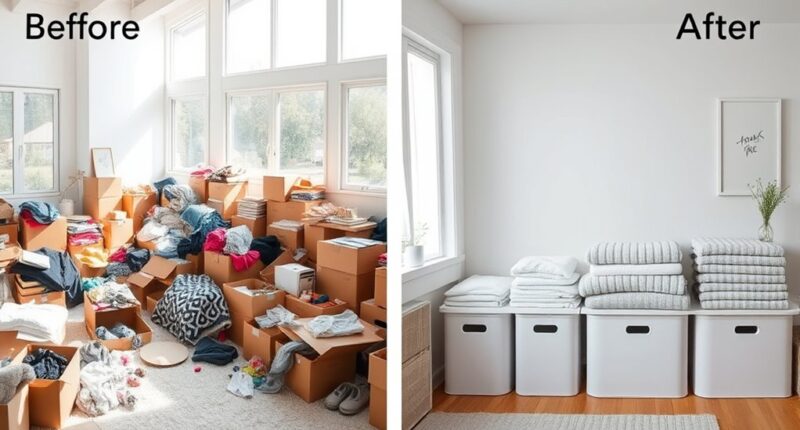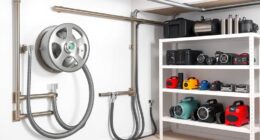Instead of rearranging clutter without a plan, focus on intentional organizing by visualizing your space and setting clear goals. Stop holding onto unnecessary items and ditch random catch-all baskets or boxes. Avoid multitasking during decluttering, as it reduces effectiveness. Don’t ignore hidden spots like drawers and behind furniture, which often hide clutter. Don’t rush—taking your time guarantees lasting results. Keep surface tidiness but prioritize deep organization to maintain a clutter-free room. Keep going to learn more about effective strategies.
Key Takeaways
- Stop rearranging clutter randomly; instead, create a clear decluttering plan before moving items.
- Avoid temporary fixes like baskets or boxes; use designated, labeled storage solutions for long-term organization.
- Don’t multitask during decluttering; focus on one area at a time to improve efficiency and reduce overwhelm.
- Stop neglecting hidden spots; regularly inspect drawers, behind furniture, and under beds for overlooked clutter.
- Avoid inconsistent or sporadic decluttering; establish a regular routine to maintain a tidy and organized space.
Avoid Rearranging Clutter Without a Plan
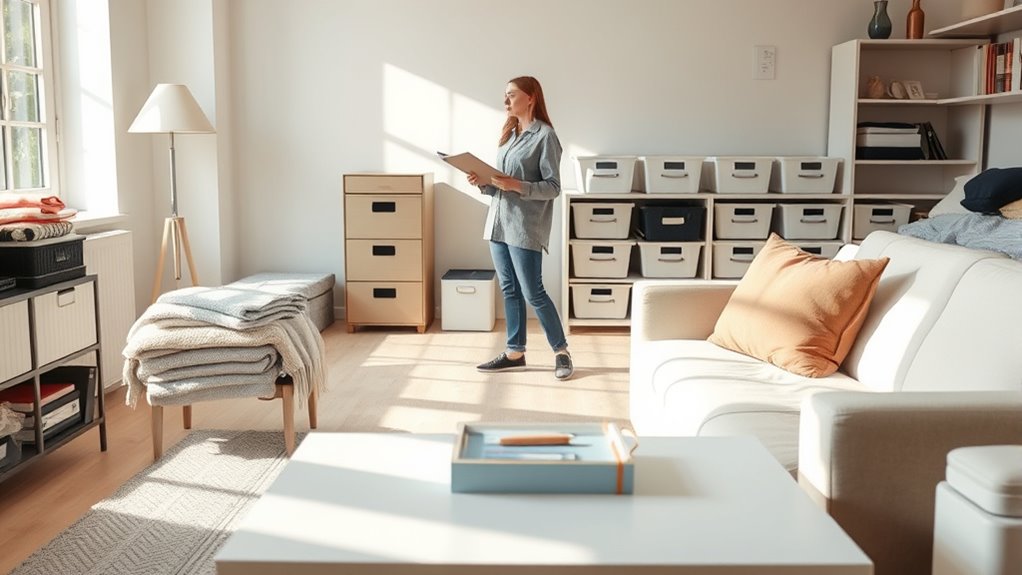
Before you start moving things around, having a clear plan in mind is vital. Strategic planning helps you see the big picture and prevents you from creating chaos. Take a moment to visualize your clutter and decide where everything should go, rather than impulsively shuffling items. Clutter visualization allows you to identify what’s essential and what can be discarded. Without a plan, you risk just relocating mess instead of reducing it. By mapping out your space and setting goals, you’ll work more efficiently and avoid frustration. This thoughtful approach ensures that each item has a purpose and contributes to a tidy, functional room. Incorporating vertical storage solutions can further optimize your space and organization efforts. Remember, a deliberate plan makes decluttering more effective and less overwhelming.
Stop Holding Onto Items You No Longer Need
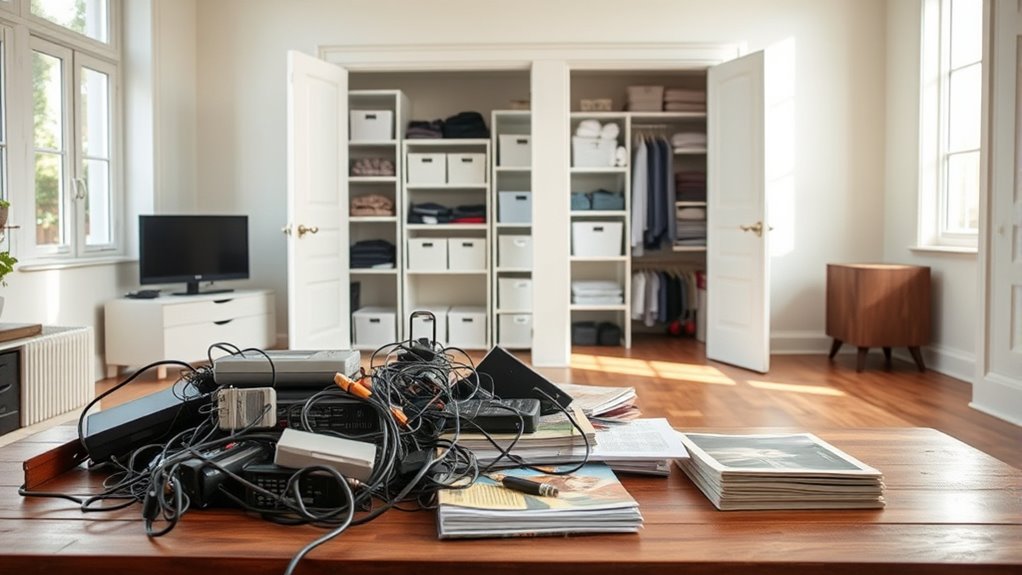
Start by recognizing which items you haven’t used in months or don’t serve a purpose anymore. Be aware of any emotional attachments that make it hard to let go, but remember that holding onto unnecessary things can clutter your space. Make thoughtful decisions to free yourself from items that no longer add value to your life. Additionally, understanding the benefits of a well-organized room can motivate you to declutter more effectively.
Recognize Unused Items
Recognizing which items you no longer need is a vital step in decluttering. Start by scanning your space for unused items—things you haven’t touched in months or no longer serve a purpose. Clutter recognition involves honestly evaluating whether each item adds value or simply takes up space. If an item is broken, outdated, or just gathering dust, it’s a clear sign you can let it go. Avoid the temptation to hold onto things out of habit or guilt; instead, focus on what’s truly necessary and functional. By identifying unused items, you create a clearer picture of what’s cluttering your space and make better decisions about what to keep or discard. This step helps you move forward with purpose and confidence. Incorporating data-driven strategies into your decluttering process can help you assess your space more objectively and efficiently.
Identify Emotional Attachments
Holding onto items because of emotional attachment can make decluttering difficult, even when those items no longer serve a practical purpose. Your emotional baggage and sentimental value can cloud judgment, making it hard to let go. To identify these attachments, ask yourself:
- Does this item remind you of a specific person or event?
- Would you feel guilty or sad if you threw it away?
- Does holding onto it provide comfort or a sense of security?
Make Thoughtful Decisions
Making thoughtful decisions about what to keep and what to let go is essential for effective decluttering. Practice mindful sorting by evaluating each item honestly—ask yourself if it’s useful, meaningful, or has a current purpose. Avoid holding onto things out of habit or guilt; instead, focus on intentional disposal. If an item no longer serves you or adds value, let it go with purpose, whether by donating, recycling, or discarding responsibly. This mindful approach prevents clutter from accumulating again and helps you create a space that truly reflects your needs and priorities. Remember, making deliberate choices allows you to regain control over your environment and fosters a more organized, peaceful room. Incorporating sustainable disposal methods can also support environmentally conscious decluttering.
Don’t Use Random Baskets or Boxes as Catch-Alls
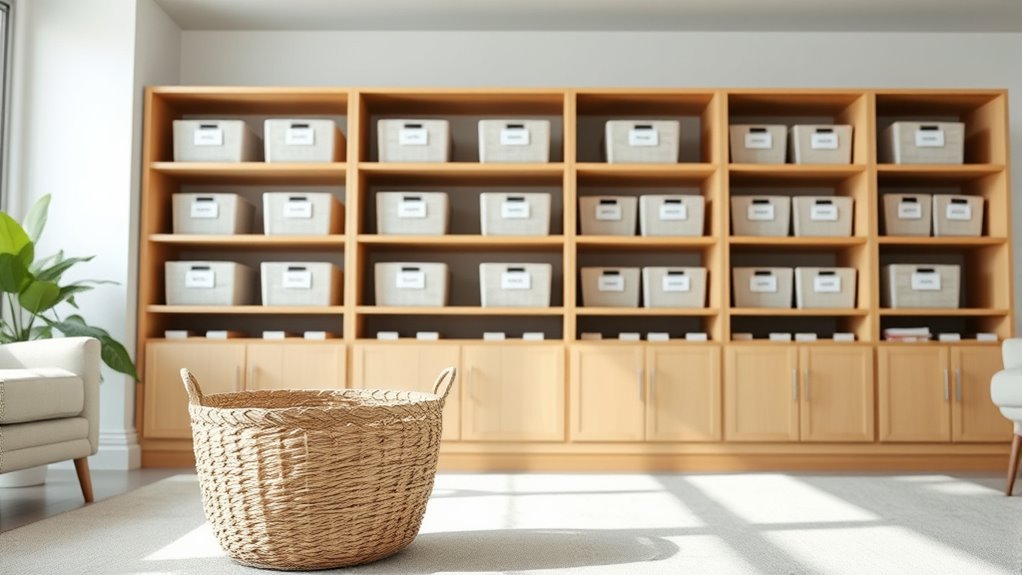
While it might seem convenient to toss miscellaneous items into random baskets or boxes, doing so can quickly create chaos rather than clarity. Instead of relying on these catch-alls, focus on intentional organization through creative storage solutions. Here’s how to improve:
Avoid chaos—organize intentionally with labeled bins and purposeful storage solutions.
- Identify specific items for each container—shoes, toys, or office supplies.
- Use labeled storage bins to streamline retrieval and prevent clutter buildup.
- Keep only what you need and love, avoiding unnecessary accumulation.
- Incorporate functional storage that complements your farmhouse bedroom aesthetic to maintain both style and order.
Skip Multitasking During Decluttering Sessions
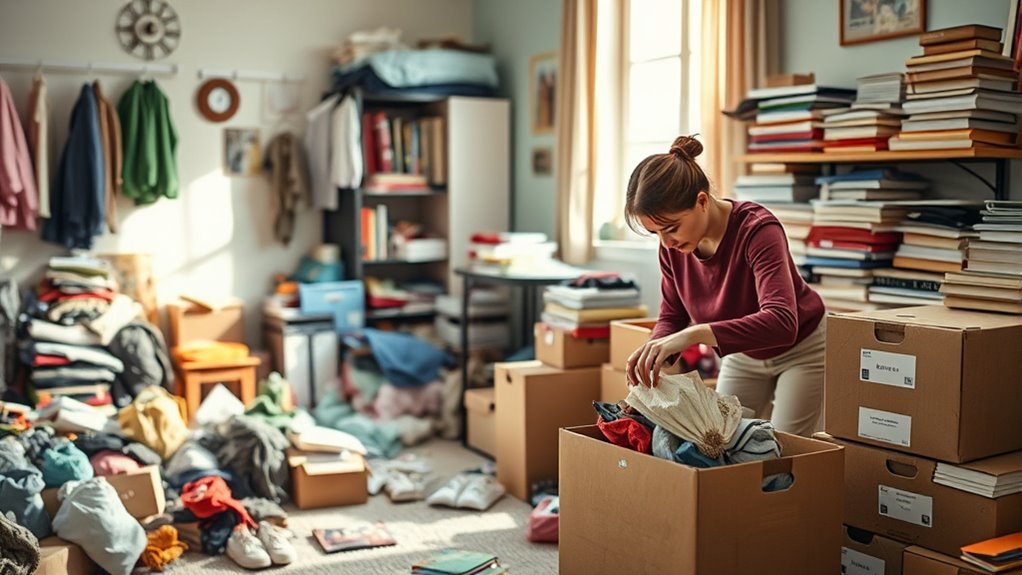
When you’re decluttering, multitasking can quickly turn into a distraction. Juggling tasks, like checking your phone or handling other chores, leads to multitasking pitfalls that stall progress. To prevent this, focus solely on decluttering. This sharp focus helps you avoid unnecessary stops and reorientations, making the process more efficient. Use the table below to identify common distraction prevention strategies:
| Strategy | Benefit | Example |
|---|---|---|
| Turn off notifications | Eliminates interruptions | Silence phone alerts during session |
| Set a timer | Creates a sense of urgency | 30-minute declutter blocks |
| Clear workspace | Reduces visual clutter | Remove unrelated items |
| Prioritize tasks | Maintains focus | Tackle one area at a time |
Staying present minimizes multitasking pitfalls, making your decluttering more effective. Additionally, understanding the importance of trustworthiness of brands can help you choose quality storage solutions or organizers that will last longer and perform better.
Refrain From Ignoring Hidden Clutter Spots
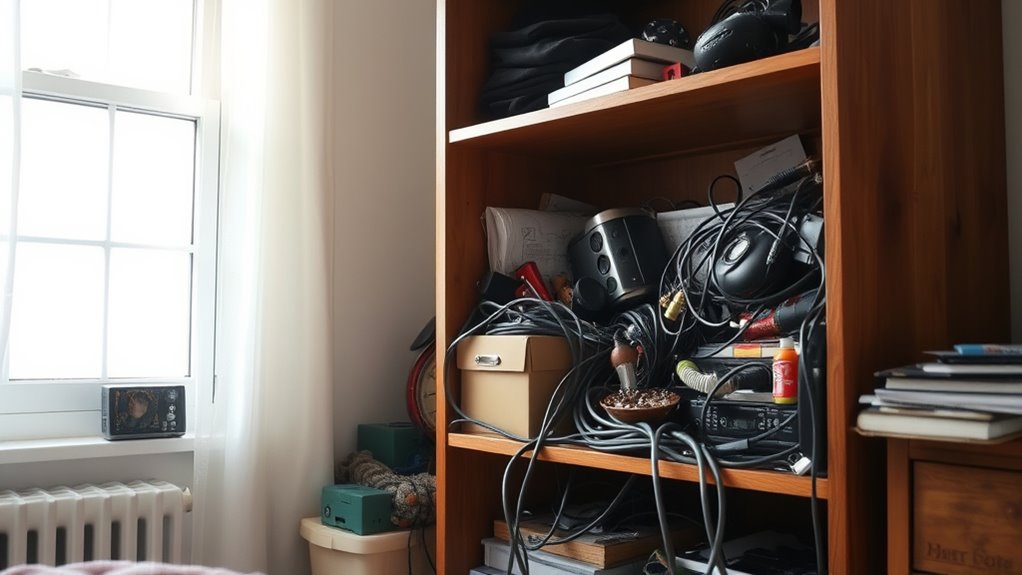
Hidden clutter spots often escape your initial scan, but ignoring them can undo your decluttering efforts. These overlooked spots, like hidden corners, can quickly fill up again if neglected. To prevent this, focus on:
Don’t forget hidden corners and tight spots—they can quickly refill if overlooked during decluttering.
- Checking behind furniture and under beds, where clutter easily hides out of sight.
- Examining drawers and cabinets for overlooked items that accumulate over time.
- Sweeping through corners and tight spaces, which often trap dust and clutter unnoticed.
- Regularly inspecting hidden storage areas to maintain a clutter-free environment.
Don’t Rush Through the Process
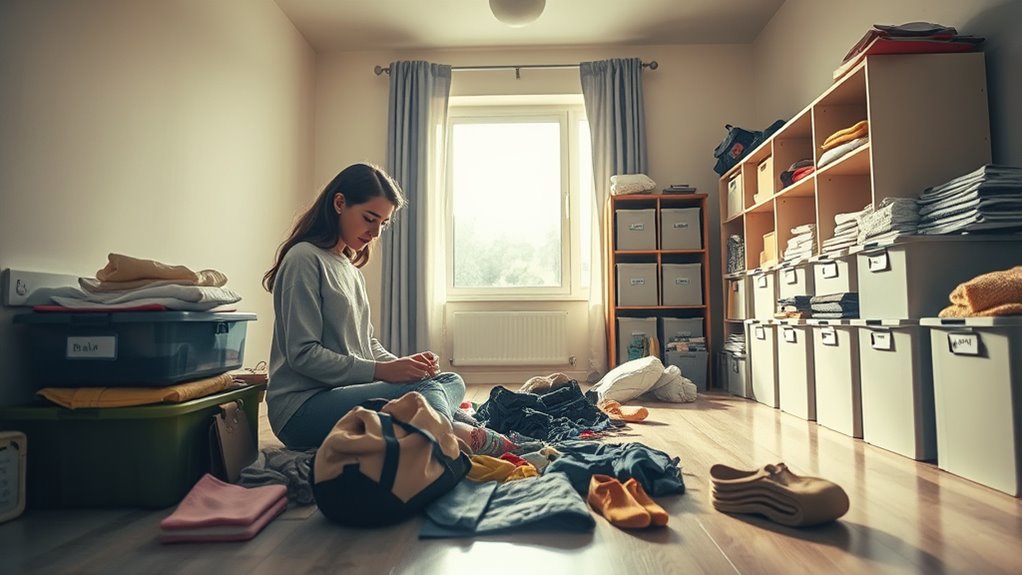
Rushing through your decluttering process can quickly lead to overlooked areas and a return of clutter. When you make hasty decisions, you’re more likely to discard items you actually want or need, causing frustration later. Rushed decluttering often results in unfinished tasks and a cluttered space that quickly reappears. Instead, take your time with each step, focusing on one area at a pace that feels manageable. This approach helps you assess each item carefully and make confident choices. Remember, decluttering isn’t a race. Slow, deliberate progress ensures you don’t overlook hidden clutter spots or create the need to redo the work. Incorporating organized storage solutions can also help maintain a clutter-free environment in the long run. Patience pays off by creating a more organized space that stays clutter-free longer.
Avoid Making Decluttering a One-Time Event

Decluttering isn’t a one-and-done task; it’s an ongoing process that requires regular maintenance. Without consistent effort, clutter quickly reappears. To stay on top of it, consider these long-term planning tips:
- Schedule weekly quick tidies to prevent buildup.
- Regularly evaluate your belongings, donating or discarding items you no longer need.
- Create designated spaces for different categories, making it easier to maintain order.
Steer Clear of Overloading Your Storage Solutions
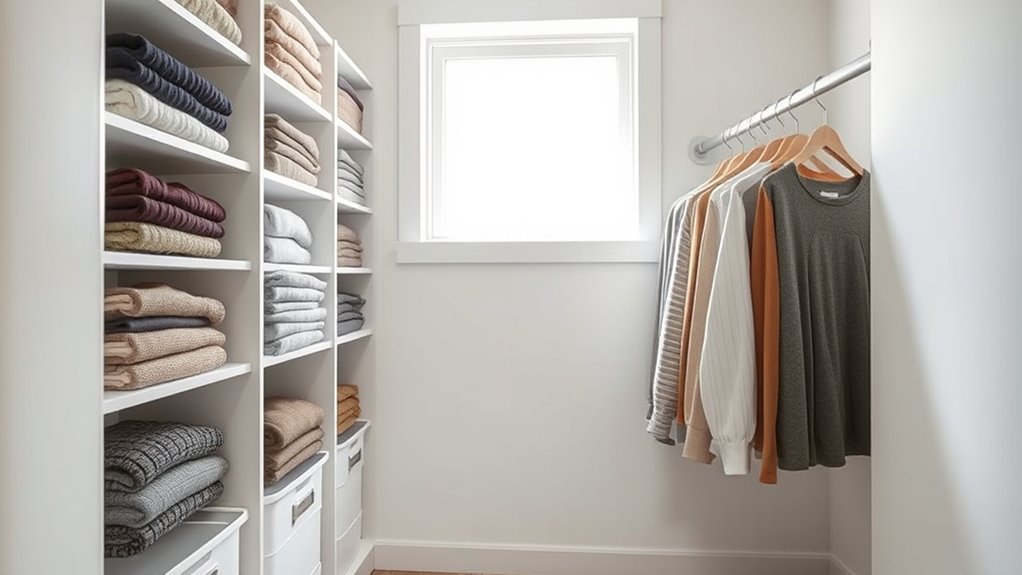
While regular tidying helps keep clutter at bay, overloading your storage spaces can quickly undo those efforts. When you cram too much into drawers, shelves, or boxes, it creates a storage overload that leads to clutter chaos. Items become harder to find, and you’re more likely to forget what’s hidden away. Instead of stuffing everything in, opt for organized, designated spots for each category of belongings. Use clear containers or labeled bins to keep things visible and accessible. Prioritize quality storage solutions that fit your space and needs, avoiding the temptation to overfill. Remember, the goal is efficient storage that simplifies your decluttering process, not one that adds stress by creating clutter chaos. Keep it simple, spacious, and manageable. Incorporating effective storage solutions can enhance your decluttering efforts and maintain a tidy environment.
Stop Focusing Only on Surface Tidiness

Focusing solely on surface tidiness might make your space look clean temporarily, but it often masks underlying clutter that can quickly reappear. Superficial cleaning gives a false sense of order without addressing the root problem. To truly declutter, avoid these pitfalls:
- Prioritize deep organization over quick fixes to improve surface appearance.
- Tackle hidden clutter in drawers, shelves, and behind furniture, not just visible surfaces.
- Regularly reassess your space to prevent clutter from building up again.
- Understanding contrast ratio helps you choose equipment that enhances visual clarity and detail, contributing to a more organized and visually appealing environment.
Frequently Asked Questions
How Can I Stay Motivated to Declutter Consistently?
You can stay motivated to declutter consistently by adopting mindset shifts that focus on the benefits of a tidy space, like reduced stress and increased productivity. Use accountability methods such as setting small, achievable goals or partnering with a friend to stay on track. Celebrate your progress regularly, and remind yourself why an organized room matters to you, helping you stay committed and motivated over time.
What Tools Are Best for Effective Decluttering?
You should use versatile storage solutions like labeled bins, drawer dividers, and shelving to keep items organized and accessible. Incorporate digital organization tools, such as cloud storage and apps, to reduce physical clutter and streamline your space. These tools make decluttering more effective by helping you categorize and store items efficiently, ensuring your room stays tidy long-term. Combining physical and digital solutions maximizes your decluttering success.
How Do I Decide What to Discard First?
Imagine your clutter as a garden overrun with weeds—your first step is choosing which to pull first. Focus on items with low emotional attachments and clear sorting priorities, like expired cosmetics or broken tools. These are easy wins that create quick progress and motivate you. Tackling less sentimental clutter first clears space and builds momentum, making it easier to handle those items you’re more emotionally attached to later.
Can Decluttering Improve Mental Health?
Yes, decluttering can improve your mental health by helping you shed emotional baggage and reduce physical clutter. When you clear out unnecessary items, you create a calmer environment that promotes relaxation and focus. This process encourages mindfulness and self-care, making you feel more in control. As a result, decluttering can boost your mood, decrease anxiety, and foster a sense of achievement, positively impacting your overall well-being.
How Often Should I Declutter Each Room?
Think of your home as a garden that needs regular tending. You should declutter each room every three to six months, focusing on clutter hotspots like the chaos corner or forgotten drawers. Use smart storage solutions to keep things tidy and prevent clutter from taking over again. Regular upkeep keeps your space revitalized and inviting, making it easier to maintain a peaceful, organized environment that feels like a gust of fresh air.
Conclusion
Did you know that clutter can increase stress levels by up to 40%? Instead of rushing or just moving things around, follow these smarter decluttering tips. Focus on creating a plan, letting go of items you no longer need, and addressing hidden spots. Remember, decluttering isn’t a one-and-done task—consistency matters. By doing so, you’ll create a calmer, more organized space that truly supports your well-being and productivity.
